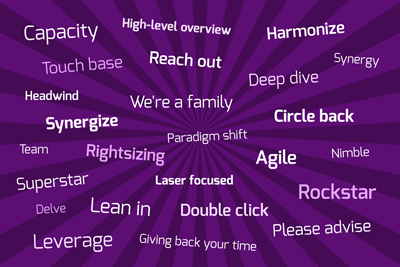American business jargon is everywhere. It fills meetings, emails, and presentations with colorful phrases that make sense to insiders — but leave outsiders scratching their heads.
For global colleagues, jargon is more than confusing — it can quietly erode trust, leaving them unsure whether to speak up, stay silent, or risk being misunderstood.

“I understood every word — but not the meaning.”
This is the hidden trap of American business jargon. The words are English. The grammar is fine. But the meaning? It often disappears in translation—confusing even fluent professionals.
- Jargon: Specialized workplace language that makes sense inside a group, but confuses outsiders (e.g., bandwidth, pivot, low-hanging fruit).
- Idioms: Everyday expressions whose meaning can’t be guessed from the words (e.g., kick the bucket, hit the books).
- Clichés: Overused phrases that have lost impact (e.g., think outside the box, at the end of the day).
Common Jargon — and Their Real Meanings
1. Hit the Ground Running
American meaning: Start quickly and effectively with no delay.
Literal meaning: Running on the ground? From what?
Clearer phrase: “Let’s get started right away.”
2. Take This Offline
American meaning: Discuss separately, outside the current meeting.
Literal meaning: Is the internet down?
Clearer phrase: “Let’s talk about this one-on-one later.”
3. Move the Needle
American meaning: Create noticeable progress.
Literal meaning: Moving what needle?
Clearer phrase: “Let’s set a measurable goal first.”
4. Low-Hanging Fruit
American meaning: Easy tasks that deliver quick wins.
Literal meaning: Are we picking fruit from a low-hanging branch?
Clearer phrase: “Start with the simpler tasks.”
5. Circle Back
American meaning: Return to a topic later.
Literal meaning: Physically circling around?
Clearer phrase: “Let’s revisit this tomorrow.”
Field Note
Japanese colleague:
“I understood the literal words my American manager used — but given the reaction in the room, I realized I had missed the meaning.”
Surface comprehension is not enough — tone, response, and action reveal the gap.
Field Note
German colleague:
“My American colleague said he’d circle back with the information and take it offline if more clarification was necessary.”
Often the promise to clarify doesn’t make up for missing clarity in the first place.
Contact us today to explore how our training and coaching solutions can equip your team to succeed — whether you're tackling global initiatives or navigating complex cross-cultural challenges. We welcome the opportunity to support your goals — across cultures, across borders, and across the global landscape.
HOME | SERVICES | CULTURAL INTELLIGENCE | EXPLORE CULTURES | INSIGHTS | ABOUT | CONTACT
Email Us | www.culturalsavvy.com | ©1999–2025 Cultural Savvy. All Rights Reserved. Terms of Use
